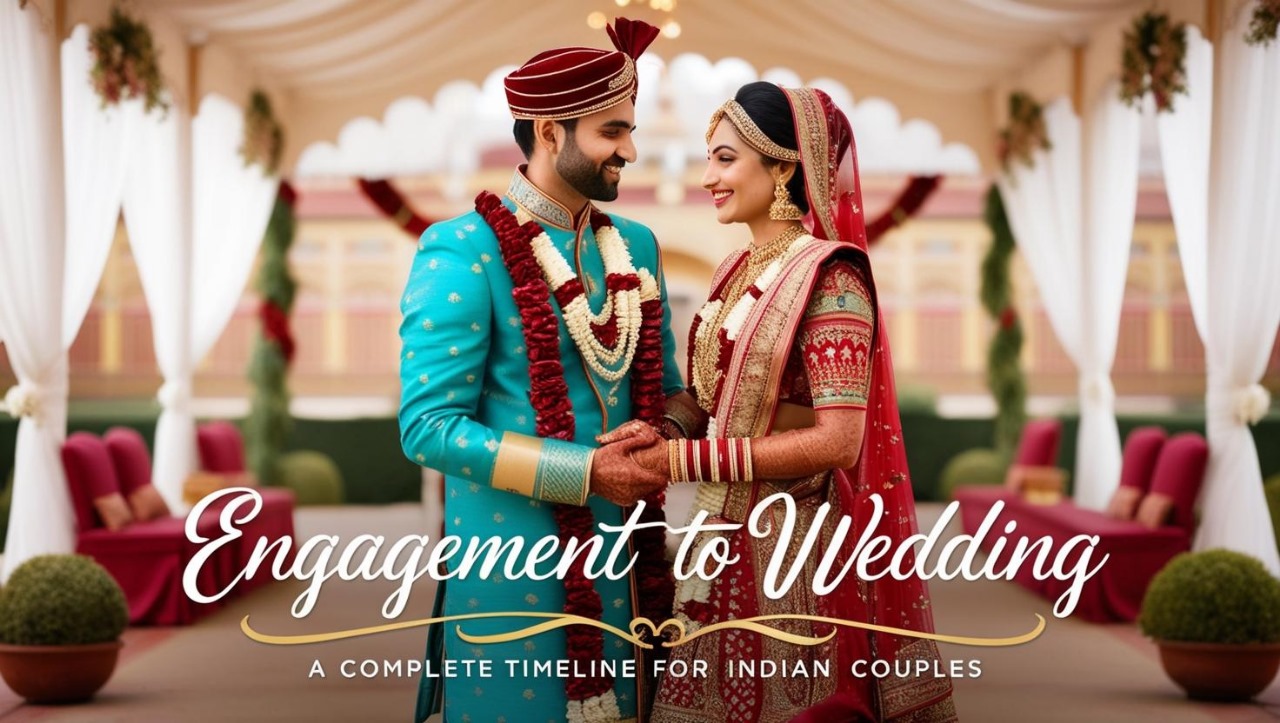For Indian couples, the time between engagement and wedding is a treasured stage that is filled with excitement, custom, and careful preparation. This timeline illustrates the change from a vow of eternal devotion to the splendor of the wedding day. The wedding process might take months or perhaps a year in India, where it combines traditional customs, family participation, and joyous festivities.
Every stage is important, from choosing auspicious dates to deciding on locations and clothing. This article provides a comprehensive schedule for Indian couples, providing a methodical approach to guarantee a smooth and happy journey from engagement to the wedding day.
1.The engagement 6 to 12 months prior to the wedding
The voyage starts with the engagement, which is sometimes referred to as the “ring ceremony” or “sagai.” Families use astrological advice to determine an auspicious wedding date, and couples exchange rings. During this time, preliminary planning is done, including creating a guest list, determining a budget, and reserving a wedding location. Couples could also begin looking into caterers, decorators, and photographers.
2.4-6 Months Prior to the Wedding: Pre-Wedding Activities
Families start making specific plans as soon as the date is decided. The process of purchasing jewelry, lehengas, and sherwanis for the wedding starts. The couple’s style and cultural background are reflected in the invitations that are created and distributed. In order to reinforce family ties, pre-wedding customs like the “roka” or “tilak” may be performed. During this stage, priests, musicians, and mehendi artists are also booked.
3.2 to 3 Months Prior: Customs and Arrangements
Finalizing details is the main goal of this stage. Couples organize the food, verify vendors, and make hotel arrangements for guests who are traveling from out of town. Pre-wedding activities such as mehendi, sangeet, and haldi are planned, frequently accompanied by dance choreography. Marriage registration and other legal requirements are covered. Makeup and clothing trials guarantee that everything is flawless.
4.1 Month Prior: The Last Countdown
As the wedding draws closer, the enthusiasm builds. Families divide duties, verify reservations twice, and do lesser customs like “pithi” or “godh bharai.” A bachelor/bachelorette party is a way for couples to relax. Now is also the time to make sure travel plans are set up and packed for the honeymoon.
5.Wedding Week: The Moment of Truth
For Indian couples, the wedding week is a happy frenzy. The fun jaimala, in which the bride and groom exchange garlands, comes after the exuberant baraat, the groom’s parade. With the use of mantras, they are united in love and devotion by the sacred pheras, which are seven vows made around a fire. Families are busy greeting visitors and overseeing celebrations with colorful décor and delicacies.
The emotive vidaai, the bride’s sad parting that signifies her new beginning, marks the conclusion of the week. The couple joins together among customs and festivities, forging treasured memories of their ethnic background and unwavering vow.
For Indian couples, the period between engagement and wedding is a lovely fusion of love, custom, and planning. It captures the richness of cultural traditions and the happiness of bringing two families together over the course of several months. Every stage has deep significance, whether it’s the heartbreaking departure at vidaai or the pledge of commitment at the engagement.
Couples can enjoy this once-in-a-lifetime experience if they carefully prepare everything from choosing dates to carrying out rituals. In addition to marking the beginning of a new chapter in the couple’s lives, the wedding day is a celebration of tradition, solidarity, and unwavering love that will last for years to come.

